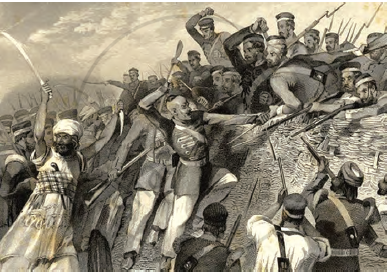Advertisements
Advertisements
प्रश्न
Write a short essay (250-300 words) on the following:
Examine any two sources presented in the chapter, choosing one visual and one text, and discuss how these represent the point of view of the victor and the vanquished.
उत्तर
Ordinary people join the mutiny of 1857. Lucknow was one of the main centres. The sepoys of Awadh were joined by peasants, zamindars, traders and talukdars.

Source Sisten and the tahsildar: In the context of the communication of the message of revolt and mutiny, the experience of Francois Sisten, a native Christian police inspector in Sitapur, is telling. He had gone to Saharanpur to pay his respects to the magistrate. Sisten was dressed in Indian clothes and sitting cross-legged. A Muslim tahsildar from Bijnor entered the room; upon learning that Sisten was from Awadh, he enquired, “What news from Awadh? How does the work progress, brother?” Playing safe, Sisten replied, “If we have work in Awadh, your highness will know it.” The tahsildar said, “Depend upon it, we will succeed this time. The direction of the business is in able hands.” The tahsildar was later identified as the principal rebel leader of Bijnor. This source indicate that the effect of the rebellions had spread even among those officers who had earlier supported the British. The English men worried about their lives, property, owner of women and children. The geographical extent of the revolt was much greater. The magistrate used to get news and daily development day to day through their governmental representatives but they were suspicious as later on magistrate of Sitapur came to know that the Sisten who came to him was a great sympathiser of the rebellions.
APPEARS IN
संबंधित प्रश्न
Answer in 100-150 Words
Discuss the Extent to Which Religious Beliefs Shaped the Events of 1857.
What is a Bell of arms?
What do you understand by the term ‘Firangi’?
Who led the revolt in Bihar?
Who was also called as ‘Danka Shah’?
Which of the following was not one of the rumours and prophecies during the 19 century?
Which of the following is an incorrect match for the Centre of the revolt and their leaders?
Who among the following mobilised the villages of Pargana Barout in Uttar Pradesh in the Revolt of 1857?
Arrange the following events in chronological order:
- Introduction of Summary Revenue Settlement
- Subsidiary Alliance introduced in Awadh
- Rani Jhansi killed in the battle
- Delhi captured by the British June
Choose the correct option.
Assertion (A): In towns and cantonments, sepoys and the common people refused to touch the atta.
Reason (R): There were rumours that the British had mixed the bone dust of cows and pigs into the flour that was sold in the market.
From where did the revolt of 1857 start?
Who led the revolt at Kanpur?
Read the following excerpt carefully and answer the question :
Rumours and prophecies played a part in moving people to action. The Sepoys who had arrived in Delhi from Meerut had told Bahadur Shah about the bullets coated with the fat of cow and pigs and that biting those bullets would corrupt their caste and religion. They were referring to the cartridges of the Enfield Rifles that had just been given to them. The British tried to explain to the Sepoys that this was not the case but the rumour of greased cartridge spread like wildfire across the Sepoy lines of North India.
Why did the Sepoys march to Delhi from Meerut?
Read the following excerpt carefully and answer the question :
Rumours and prophecies played a part in moving people to action. The Sepoys who had arrived in Delhi from Meerut had told Bahadur Shah about the bullets coated with the fat of cow and pigs and that biting those bullets would corrupt their caste and religion. They were referring to the cartridges of the Enfield Rifles that had just been given to them. The British tried to explain to the Sepoys that this was not the case but the rumour of greased cartridge spread like wildfire across the Sepoy lines of North India.
Consider the following statements:
a) The greased cartridges were to be used in the new Enfield Rifles.
b) The British officers tried to explain to the Sepoys that cartridges were not greased. It was just a rumour.
Choose the correct option:
From where did the revolt of 1857 start?
Consider the following statements regarding the revolt of 1857:
- Late in the afternoon of 10 May 1857, the sepoys in the cantonment of Meerut broke out in mutiny which began in the lines of the native infantry, spread very swiftly to the cavalry and then to the city
- The ordinary people of the town and surrounding villages joined the sepoys. The sepoys captured the bell of arms where the arms and ammunition were kept and proceeded to attack white people, and to ransack and bum their bungalows and property.
- The sepoys arrived at the gates of the Red Fort early in the morning on 11 May.
Which of the following statement(s) is/ are correct?
The tradition of Sati was abolished in the year:
"The Sepoys Mutiny and the rebellion of 1857" written by:
Who had started the Home Rule Movement in India?
At which place mutiny broke out on 10th May, 1857?
The Sepoys of Revolt 1857, arrived Delhi on ______.
Nana Saheb was selected to led the Revolt of 1857 from ______.
Shah Mal become the leaders of Revolt 1857 of Pargana Baraut in ______.
Consider the following statements regarding revolt of 1857.
- Mughal Emperor Bahadur Shah was declared as the leader of sepoys.
- There was no participation of common people.
- Moneylenders and the rich were attacked.
Which of the above statement is/are correct?
How did rumours play an important part in the Revolt of 1857? Explain with examples.
Who among the following led the Flag of the Revolt 1857 against the British in Bihar?
